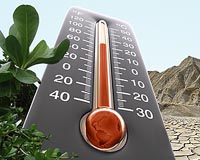| . |  |
. |
Newark, DE (SPX) May 20, 2010 In the May 7 edition of Physical Review Letters, a journal of the American Physical Society, an international team led by University of Delaware researchers reports new findings about helium that may lead to more accurate standards for how temperature and pressure are measured. In the article, highlighted as an "Editor's Suggestion" by the journal, the scientists provide a new theoretical computation of the force acting between a pair of helium atoms, referred to as "pair potential," that is more accurate than any published to date. Krzysztof Szalewicz, professor in the UD Department of Physics and Astronomy, led the study, which involved Wojciech Cencek, a postdoctoral researcher at UD, and colleagues from the University of Warsaw and Adam Mickiewicz University in Poland, and the University of Oslo in Norway. Most of us know helium as a gas for filling party balloons or for making your voice temporarily sound like a cartoon character's. But this element named for the sun is used in lasers for eye surgery, to cooling agents in nuclear reactors. Helium has a number of characteristics that make it special, Szalewicz says. It is the most stable of all the elements and has the lowest boiling point. It becomes a fluid at temperatures close to absolute zero while most other materials are a solid. In fact, helium is a liquid even at absolute zero and becomes a solid only at high pressure. Helium is the only substance that exhibits superfluidity, and it will not burn or react with other elements, which is one reason why it is used as a pressurizing agent for liquid fuel rockets in space exploration, among many other applications. "Of all the elements, helium is closest to the ideal gas," Szalewicz says. "Two helium atoms form the weakest bound diatomic molecule. All the properties of temperature, for example, which is a measure of the kinetic energy of particles in matter, can be modeled if the force acting between a pair of helium atoms is known. "This has been the subject of extensive activity," Szalewicz notes, "as accurate knowledge of the pair potential of helium is of importance in several branches of science, including low-temperature condensed matter physics, spectroscopy, and metrology, which is the science of measurement." The research team used complex numerical techniques to compute several physical effects in the helium pair potential which are rarely considered in molecular physics. These effects include couplings of the electronic and nuclear motions, contributions due to Einstein's special relativity, and the so-called quantum electrodynamics contributions due to the interaction of the electrons with the electromagnetic field. The scientists predict that the binding energy of two molecules of helium, chemically referred to as a "dimer," is 6,790 times smaller than the potential depth, and the average separation between the atoms is 47 angstroms compared to the typical chemical bond length of about 1 angstrom. The estimated uncertainties of the theoretical results are an order of magnitude smaller than the best experimental ones, they report. The thermophysical properties of gaseous helium computed from this potential now will be used to calibrate the apparatus for measuring properties such as viscosities or the speed of sound. "These calculations should lead to new, better standards for quantities such as temperature or pressure," Szalewicz says. "Continuous improvement of metrology standards is important for progress in experimental science, as well as in many industrial applications." The research was supported in part by grants from the National Institute of Standards and Technology and the National Science Foundation.
Share This Article With Planet Earth
Related Links University of Delaware Weather News at TerraDaily.com
 42226 Daily Temperature Readings And Counting
42226 Daily Temperature Readings And CountingNew York NY (SPX) May 10, 2010 Every day since Jan. 1, 1896, an observer has hiked to a spot at The Mohonk Preserve, a resort and nature area some 90 miles north of New York City, to record daily temperature and other conditions there. It is the rarest of the rare: a weather station that has never missed a day of temperature recording; never been moved; never seen its surroundings change; and never been tended by anyone but a ... read more |
|
| The content herein, unless otherwise known to be public domain, are Copyright 1995-2010 - SpaceDaily. AFP and UPI Wire Stories are copyright Agence France-Presse and United Press International. ESA Portal Reports are copyright European Space Agency. All NASA sourced material is public domain. Additional copyrights may apply in whole or part to other bona fide parties. Advertising does not imply endorsement,agreement or approval of any opinions, statements or information provided by SpaceDaily on any Web page published or hosted by SpaceDaily. Privacy Statement |